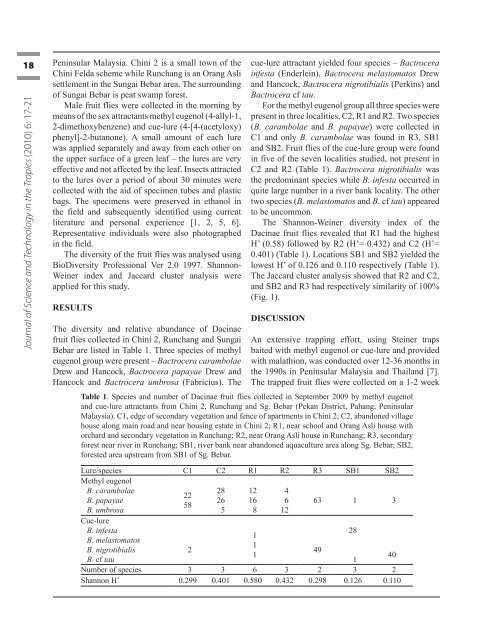Download - Akademi Sains Malaysia
Download - Akademi Sains Malaysia
Download - Akademi Sains Malaysia
You also want an ePaper? Increase the reach of your titles
YUMPU automatically turns print PDFs into web optimized ePapers that Google loves.
18<br />
Journal of Science and Technology in the Tropics (2010) 6: 17-21<br />
Peninsular <strong>Malaysia</strong>. Chini 2 is a small town of the<br />
Chini Felda scheme while Runchang is an Orang Asli<br />
settlement in the Sungai Bebar area. The surrounding<br />
of Sungai Bebar is peat swamp forest.<br />
Male fruit flies were collected in the morning by<br />
means of the sex attractants methyl eugenol (4-allyl-1,<br />
2-dimethoxybenzene) and cue-lure (4-[4-(acetyloxy)<br />
phenyl]-2-butanone). A small amount of each lure<br />
was applied separately and away from each other on<br />
the upper surface of a green leaf – the lures are very<br />
effective and not affected by the leaf. Insects attracted<br />
to the lures over a period of about 30 minutes were<br />
collected with the aid of specimen tubes and plastic<br />
bags. The specimens were preserved in ethanol in<br />
the field and subsequently identified using current<br />
literature and personal experience [1, 2, 5, 6].<br />
Representative individuals were also photographed<br />
in the field.<br />
The diversity of the fruit flies was analysed using<br />
BioDiversity Professional Ver 2.0 1997. Shannon-<br />
Weiner index and Jaccard cluster analysis were<br />
applied for this study.<br />
RESULTS<br />
The diversity and relative abundance of Dacinae<br />
fruit flies collected in Chini 2, Runchang and Sungai<br />
Bebar are listed in Table 1. Three species of methyl<br />
eugenol group were present – Bactrocera carambolae<br />
Drew and Hancock, Bactrocera papayae Drew and<br />
Hancock and Bactrocera umbrosa (Fabricius). The<br />
cue-lure attractant yielded four species – Bactrocera<br />
infesta (Enderlein), Bactrocera melastomatos Drew<br />
and Hancock, Bactrocera nigrotibialis (Perkins) and<br />
Bactrocera cf tau.<br />
For the methyl eugenol group all three species were<br />
present in three localities, C2, R1 and R2. Two species<br />
(B. carambolae and B. papayae) were collected in<br />
C1 and only B. carambolae was found in R3, SB1<br />
and SB2. Fruit flies of the cue-lure group were found<br />
in five of the seven localities studied, not present in<br />
C2 and R2 (Table 1). Bactrocera nigrotibialis was<br />
the predominant species while B. infesta occurred in<br />
quite large number in a river bank locality. The other<br />
two species (B. melastomatos and B. cf tau) appeared<br />
to be uncommon.<br />
The Shannon-Weiner diversity index of the<br />
Dacinae fruit flies revealed that R1 had the highest<br />
H’ (0.58) followed by R2 (H’= 0.432) and C2 (H’=<br />
0.401) (Table 1). Locations SB1 and SB2 yielded the<br />
lowest H’ of 0.126 and 0.110 respectively (Table 1).<br />
The Jaccard cluster analysis showed that R2 and C2,<br />
and SB2 and R3 had respectively similarity of 100%<br />
(Fig. 1).<br />
DISCUSSION<br />
An extensive trapping effort, using Steiner traps<br />
baited with methyl eugenol or cue-lure and provided<br />
with malathion, was conducted over 12-36 months in<br />
the 1990s in Peninsular <strong>Malaysia</strong> and Thailand [7].<br />
The trapped fruit flies were collected on a 1-2 week<br />
Table 1. Species and number of Dacinae fruit flies collected in September 2009 by methyl eugenol<br />
and cue-lure attractants from Chini 2, Runchang and Sg. Bebar (Pekan District, Pahang, Peninsular<br />
<strong>Malaysia</strong>). C1, edge of secondary vegetation and fence of apartments in Chini 2; C2, abandoned village<br />
house along main road and near housing estate in Chini 2; R1, near school and Orang Asli house with<br />
orchard and secondary vegetation in Runchang; R2, near Orang Asli house in Runchang; R3, secondary<br />
forest near river in Runchang; SB1, river bank near abandoned aquaculture area along Sg. Bebar; SB2,<br />
forested area upstream from SB1 of Sg. Bebar.<br />
Lure/species C1 C2 R1 R2 R3 SB1 SB2<br />
Methyl eugenol<br />
B. carambolae<br />
B. papayae<br />
B. umbrosa<br />
Cue-lure<br />
B. infesta<br />
B. melastomatos<br />
B. nigrotibialis<br />
B. cf tau<br />
22<br />
58<br />
2<br />
28<br />
26<br />
5<br />
12<br />
16<br />
8<br />
1<br />
1<br />
1<br />
4<br />
6<br />
12<br />
63 1 3<br />
Number of species 3 3 6 3 2 3 2<br />
Shannon H’ 0.299 0.401 0.580 0.432 0.298 0.126 0.110<br />
Jostt vol 6.indd 18 7/22/10 10:08:42 PM<br />
49<br />
28<br />
1<br />
40

















